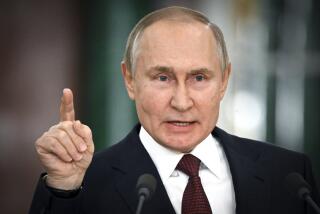Soviet Economy Shows Rapid Growth in 1986 : 4.2% Rate Tops U.S. Mark of 2.5%; Analysts See ‘Breathing Room’ for Gorbachev Changes
- Share via
WASHINGTON — Reflecting impressive gains under Soviet leader Mikhail S. Gorbachev, the Soviet economy grew 4.2% in 1986, twice the average growth rate for the previous decade and considerably greater than the U.S. increase of 2.5% last year, the chief U.S. intelligence agencies reported Thursday.
The excellent economic performance, largely attributable to a record farm harvest and to less loss of work time in factories, gives Gorbachev “breathing room” to continue his highly ambitious program for economic, political and social change, according to the joint CIA-Defense Intelligence Agency analysis.
However, slower economic growth is “probable” through 1990, the agencies predicted, and they noted that Gorbachev’s program is “inherently risky, (so) things could just as easily go wrong,” even in the short term.
First Detailed Evaluation
The report, presented to Congress’ Joint Economic Committee, provides the first detailed evaluation of the Soviet leader’s economic agenda after two years on the job.
It comes, coincidentally, in the same week that two U.S. experts on Soviet affairs told Congress that Gorbachev could be ousted by conservative opponents in three to four years if he continues to press his dramatic reforms.
“He’s stepping on so many toes” that “he won’t last four years,” Marshall Goldman of Harvard’s Russian Research Center predicted in a hearing earlier this week. Peter Reddaway, director of the Smithsonian Institution’s Kennan Institute for Advanced Russian Studies, offered a similar assessment but warned that it is “utterly speculative.”
Other Soviet specialists are more cautious, but the consensus is that Gorbachev cannot continue in power indefinitely without showing an improved Soviet economy as a result of his economic reforms and his glasnost, or openness, campaign.
Sen. William Proxmire (D-Wis.), a Joint Economic Committee member, summed up the intelligence agencies’ analysis: “Gorbachev, in effect, is attempting to retool Soviet industry to catch up with the United States and the West. The report shows that there may be some improvements in Soviet performance but little likelihood that the Soviets will catch up.”
In most advanced manufacturing technologies, the report said, the Soviet Union “remains years behind the United States.” The technology lag is seven to 12 years in such areas as computers and microprocessors and affects both their weapons development and their civilian production processes, the document added.
However, the areas of economic gain in 1986 were significant.
Soviet agriculture, whose output had shrunk during the previous two years, grew by 7.3%. The grain harvest of 210 million tons was the highest since 1978. Livestock production also increased.
Industry had its best year in a decade. Production targets for machinery were generally exceeded. Energy branches, despite the Chernobyl nuclear accident, showed healthy growth, while coal and natural gas goals were exceeded. Oil, a major hard-currency earner, returned to 1983 production levels of 12.3 million barrels after slumps in the intervening years.
Labor productivity improved after decades of steady decline. This largely could be attributed to reduced loss of work time to drunkenness and also to increased discipline at factories and better management.
“Partly as the result of (Gorbachev’s) leadership, partly as a result of some changes instituted by his predecessors and partly as a result of some good luck, 1986 turned out to be a very good year for the economy,” the intelligence agencies said.
Two-Step Approach
Gorbachev’s campaign to improve the Soviet economy is set out in a two-step approach.
First, through his campaigns against alcohol, corruption and lax discipline, he is seeking to strengthen Communist Party control, improve worker attitudes and weed out incompetents. He expects this to produce what he calls “human factor” gains.
Second, over the longer term, he is counting on major productivity gains from organizational changes and an ambitious modernization program to upgrade the country’s plants and equipment.
However, the report labeled Gorbachev’s program as “too ambitious on a number of counts” and predicted a decline in the growth rate in future years.
“Meeting output targets . . . would require unrealistic gains in productivity,” the document said. Also, it noted that increasing quality and quantity are not easily compatible goals and that there has been no great change in economic incentives to encourage management innovation and technological change.
Already, significant resistance to specific Gorbachev policies has surfaced in both the government and the party bureaucracy as factory managers complain about the simultaneous quantity-quality demands.
Also, “despite his frenetic efforts over the past two years, we still do not see a viable, integrated plan for modernization (of the Soviet economy); rather we see many individual programs being put forth, each dealing with one facet of the economy,” the report said.
The analysts predicted that the average growth for the rest of the decade “will fall well short of the implied goal of 4%,” adding, “The 5% (per year) target for 1991-2000 appears to be out of reach.”
While the economic gains were being registered in 1986, the analysts said, Soviet spending on the military grew by 3%, the same rise as in 1985 but greater than the 2% increase in previous years, the report said.
The growth did not represent a change in Gorbachev’s defense spending policy, the agencies concluded, but rather the start-up or acceleration of production of new weapon systems, primarily aircraft and missiles.
More to Read
Sign up for Essential California
The most important California stories and recommendations in your inbox every morning.
You may occasionally receive promotional content from the Los Angeles Times.










